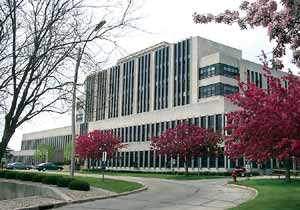Forest Products Laboratory
Our Research Works for You
The long-term health of our Nation’s forests depends
on sound conservation practices, including utilization. Since 1910, the
Forest Products Laboratory (FPL) in Madison, Wisconsin, has used science
and technology to conserve and extend our Nation’s forest resources.
Our mission is to promote healthy forests and forest-based economies through
the efficient, sustainable use of wood.
- Healthier forests
- Cleaner environment
- Building strong rural economies
- Biobased energy
- Improving America's housing
Through decades of research, the Forest Products Laboratory
has evolved along with our changing forest resource and the changing needs
of society.
As we look to the future, FPL is directing our research efforts
toward five emerging areas of study:
- Advanced composites
- Advanced wood structures
- Biorefining and bioenergy
- Nanotechnology, and
- Small-diameter timber utilization
Advances in these critical areas of study are vital to sustaining our forest
resource and keeping our country’s forest products industry competitive
in a global market.
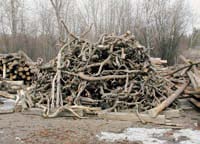 Biorefinery Biorefinery
Researchers are expanding our knowledge of forest biorefinery concepts
to make the process economically feasible and highly productive.
- Forest biomass, in addition to traditional products, can be used to
create many valuable new products, including electricity, liquid fuels,
and useful chemicals.
- Creating renewable products will reduce dependency on fossil fuels,
create sustainability through green fuels, reduce greenhouse gas emissions,
and improve efficient use of waste materials.
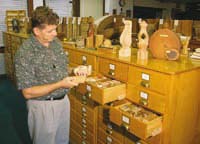 Center
for Wood Anatomy Research Center
for Wood Anatomy Research
Researchers study the fundamental structure of wood
and maintain the world's largest wood collection, containing more than
100,000 specimens.
- Researchers are developing new methods for wood identification and expanding
our knowledge of lesser-known native and foreign commerical woods.
- Researchers study topics such as the relationship between wood anatomy
and wood properties and the interplay between wood anatomy and tree growth.
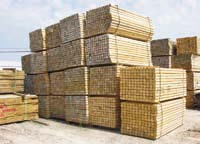 Economics Economics
FPL’s economics group provides information for the Forest Service and
industry to plan for the future.
- How wood is used in the economy.
- How and why wood use changes over time.
- Changes in the kinds and amounts of wood and fiber needs.
- Natural resource management needs and environmental impacts.
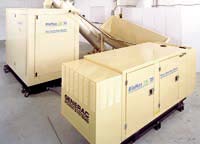 Energy and Biomass Energy and Biomass
Small trees crowding our forests and other types of biomass are an abundant source of energy.
- Biomass systems provide reliable and efficient sources of heat and power using both agricultural and forest residues.
- Small-scale biomass systems that produce 15 kW of electricity by gasifying wood chips are being demonstrated nation wide.
- Researchers are looking for ways to produce ethanol from agricultural wastes, such as corn hulls and cobs, and woody materials.
 Engineered Bio-Composites Engineered Bio-Composites
Wood-based composites promote sustainable forestry by using renewable, recyclable resources to create high-performance, high-value products.
- Research improves existing building materials, such as plywood, oriented strandboard and medium-density fiberboard, and develops the next generation of composites.
- Research develops new form-molded and extruded building products for composite lumber, siding and roofing materials, and lightweight, recyclable automotive parts.
- Researchers engineer composites to better meet user needs and address national issues such as recyclability, reduction of forest fuels, and safety and accessibility of playgrounds.
 Fire Fire
Fire is a major threat to our Nation’s forests and our homes. FPL studies the science of fire in both environments.
- Researchers play a role in the National Fire Plan by developing products from undervalued forest thinnings.
- Engineered wood products are studied to ensure their fire safety and improve their performance in a fire.
- Researchers work to reduce fire hazards in the wildland–urban interface by improving fire safety recommendations for wood structures.
 Mechanical Testing of Wood Mechanical Testing of Wood
The Engineering Mechanics Laboratory tests and evaluates wood and wood products to determine their mechanical and material properties.
- Provides information for committees who develop engineering standards for wood use.
- Collects data on small-diameter and deconstructed lumber to facilitate standards development for these abundant sources of wood.
- Provides support for FPL’s research units.
 Moisture and Durability in Buildings Moisture and Durability in Buildings
Better building design and operation can extend the service life of wood products in buildings.
- Studies to improve building designs can lead to better moisture control, longer service life of wood products, less mold, and better health for the building occupants.
- Researchers participate in national committees to help improve standards for building construction, design, and building products
 Nanotechnology Nanotechnology
Researchers are studying the unique qualities of nanomaterials to develop new products with performance capabilities never before possible.
- Nanotechnology could be used to create new wood, composite, or paper products, or wood could become a source of nanomaterials for use in other industries.
- Future possibilities include wood and paper products with built-in nanosensors that measure forces, moisture, or temperature or even report attacks by wood-decaying fungi or termites.
- Benefits of nanotechnology extend far beyond forest products into areas such as sustainable energy production, storage, and use.
 Recycling Recycling
Improved recycling processes keep waste out of landfills and extend our forest
resource.
- Advanced technologies are being developed to more easily remove inks and adhesives from recycled paper.
- Researchers partnered with the U.S. Postal Service to develop an adhesive that wouldn’t gum up recycling equipment. The result, found on “lickless” stamps, allows 20 million more tons of waste paper to be recycled in the United States annually.
- Recycling building materials through deconstruction can reduce the estimated 1 billion board feet of lumber that is landfilled each year.
 Small-Diameter Timber Small-Diameter Timber
Finding valuable uses for small-diameter wood benefits the environment and the economy.
- Thinning this material to restore natural conditions improves forest health and reduces the risk of wildfires and insect and disease infestations.
- Creating products such as furniture and flooring offsets the high cost of thinning.
- Finding valuable uses for small-diameter material, including water filters and composite signs, helps rural businesses grow and boosts local economies.
 Wood Adhesives Wood Adhesives
Improved adhesives are needed to create many of today’s wood products, which are often made from smaller wood fragments that are bonded together.
- Researchers study the chemical and structural composition of adhesives and wood, and the interaction between them, to create more durable bonds.
- Increasing our understanding of how moisture weakens wood bonds will lead to better solutions to this common problem.
- Researchers aim to make adhesives more environmentally sound by using more biomass in the formulations and by addressing concerns over use and disposal of wood adhesives.
 Wood Preservation and Biodeterioration Wood Preservation and Biodeterioration
Preservation extends the life of wood products, conserves our wood resource, and reduces economic and resource losses from wood decay and insect damage.
- New preservatives are being developed to treat small-diameter timber and widen the possibilities of its use.
- Researchers are looking for ways to reduce the impact of preservatives on the environment, such as using reduced levels of chemicals, developing low toxicity wood protection systems, and developing new treatment processes that reduce leaching.
 Wood Processing Wood Processing
Many steps are required to transform a tree into useable products.
- Researchers developed a technique that uses ultrasound, lasers, vibration, and wireless technology to test trees and wood products for decay or other defects.
- Researchers developed a series of schedules for efficiently drying wood to minimize warps, splits, and other problems.
- FPL researchers and State & Private Forestry sawmill specialists developed the Best Opening Face sawing simulation program, which calculates how to get the greatest volume of lumber from softwood logs.
 Wood Surface Chemistry Wood Surface Chemistry
Researchers work to define and control the surface properties of wood to improve:
- Resistance of wood to the effects of moisture and sunlight.
- Sorption capacity for removing contaminants from water.
- Adhesion strength in wood and wood–plastic composites.
- Durability and service life of wood products used in housing.
 Pulp and Paper Pulp and Paper
Researchers work to continuously improve the papermaking process.
- A new bleaching process that uses polyoxometalates (POMs) instead of
chlorine reduces the impact of papermaking on our water supply.
- Using POMs gives paper mills the ability to bleach small-diameter and
mixed species pulp.
- Biopulping uses decay fungi to break down wood chips prior to mechanical
pulping, reducing energy consumption by 30%.
 Interested in working with FPL? Interested in working with FPL?
With a diverse field of experts working together in one location, a customer-focused commitment to technology transfer, and many flexible partnership opportunities that can be tailored to your specific needs, the Forest Products Laboratory can help turn research results into products and processes useful to society.
FPL has a history of successful partnerships with industry, academia, trade associations, tribes, nongovernment organizations, and other federal, state, and local government agencies.
Contact us and find out what we can accomplish by working together:
USDA
Forest Service Forest Products Laboratory
One Gifford Pinchot Drive, Madison, WI 53726
Voice: 608–231–9200
FAX: 608–231–9592
Email: mailroom_forest_products_laboratory@fs.fed.us
The USDA prohibits discrimination in all its programs and activities on the
basis of race, color, national origin, sex, religion, age, disability, political
beliefs, sexual orientation, or marital or familial status. (Not all prohibited
bases apply to all programs.) Persons with disabilities who require alternative
means for communication of program information (Braille, large print, audiotape,
etc.) should contact:
USDA’s TARGET Center
Voice and TDD:
(202) 720–2600
To file a complaint of discrimination, write:
USDA, Director, Office
of Civil Rights,
Room 326-W, Whitten Building,
1400 Independence Avenue, SW,
Washington, DC 20250–9410
Call voice and
TDD: (202) 720–5964.
USDA is an equal opportunity provider and employer.
September 2006
Back to Top of Page
|

